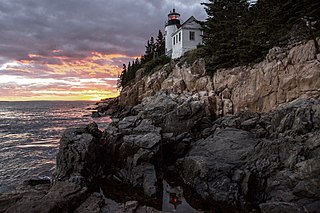
Acadia National Park is an American national park located along the mid-section of the Maine coast, southwest of Bar Harbor. The park includes about half of Mount Desert Island, part of the Isle au Haut, the tip of the Schoodic Peninsula, and portions of sixteen smaller outlying islands.
Saint Croix Island, long known to locals as Dochet Island, is a small uninhabited island in Maine near the mouth of the Saint Croix River that forms part of the Canada–United States border separating Maine from New Brunswick. The island is in the heart of the traditional lands of the Passamaquoddy people who, according to oral tradition, used it to store food away from the dangers of mainland animals. The island was the site of an early attempt at French colonization by Pierre Dugua, Sieur de Mons in 1604. In 1984 it was designated by the United States Congress as Saint Croix Island International Historic Site. There is no public access to the island, but there is a visitor contact station on the U.S. mainland and a display on the Canadian mainland opposite the island.

Islesford is a hamlet located on Little Cranberry Island in Hancock County, Maine, United States. It is one of the five islands of the town of Cranberry Isles. It lies in the Atlantic Ocean southeast of Mount Desert Island, which is the site of Acadia National Park. As of 2013, the year-round population was approximately sixty-five.

Bear Island is an 11-acre (4.5 ha) island located in Maine, United States. It is one of the five islands of the Town of Cranberry Isles. The island is located just off Northeast Harbor and south of Mount Desert Island.

Bass Harbor Head Light is a lighthouse located within Acadia National Park in the southwest portion of Mount Desert Island, Maine, marking the entrance to Bass Harbor and Blue Hill Bay.
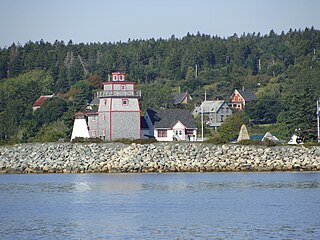
LaHave is a Canadian community in Lunenburg County, Nova Scotia. The community is located across the river from Riverport and approximately 15 kilometres from the town of Bridgewater. Once the capital of Acadia, it is located on Highway 331 at the mouth of the 97 km long LaHave River.
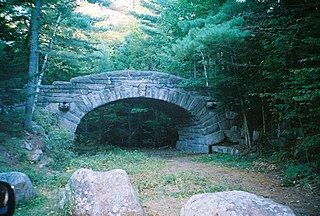
Acadia National Park, largely on Mount Desert Island, off the coast of the U.S. state of Maine, was created in part by land and other donations by John D. Rockefeller Jr. Between 1919 and 1931, Rockefeller, who was opposed to the introduction of automobiles on the island, personally oversaw the construction of a network of carriage roads, closed to motorized vehicles, on the eastern half of the island, including sixteen granite bridges and two gatehouses. The major portion of this network now falls within the bounds of the national park, and was listed on the National Register of Historic Places in 1979.

The Capt. John Wilson House and Bates Ship Chandlery are historic buildings at 4 Elm Street in Cohasset, Massachusetts. They are now owned by the Cohasset Historical Society. Open in the summer, the Captain John Wilson House is now a historic house museum, and the Chandlery houses displays about the town's maritime heritage. They were added to the National Register of Historic Places in 2002.

Bear Island Light is a lighthouse on Bear Island near Mt. Desert Island, at the entrance to Northeast Harbor, Maine. It was first established in 1839. The present structure was built in 1889. It was deactivated in 1981 and relit as a private aid to navigation by the Friends of Acadia National Park in 1989. Bear Island Light was listed on the National Register of Historic Places as Bear Island Light Station on March 14, 1988.

Great Duck Island Light is a lighthouse on Great Duck Island in the town of Frenchboro, Maine, USA. Established in 1890, the light marks the approach to Blue Hill Bay and the southern approaches to Mount Desert Island on the central coast of Maine. The light was listed on the National Register of Historic Places as Great Duck Island Light Station on March 14, 1988. The light is an active aid to navigation maintained by the United States Coast Guard; the property is owned by the College of the Atlantic, which operates a research station there.
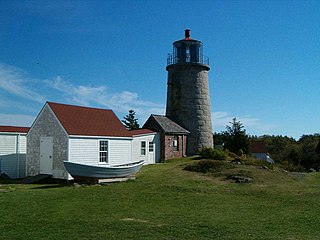
Monhegan Island Light is a lighthouse on Monhegan Island, Maine. It was first established in 1824. The present structure was built in 1850. It was Alexander Parris's last significant design. It is the second highest light in Maine — Seguin Light, with a 6-foot taller tower, is 2 feet higher in elevation. It was listed on the National Register of Historic Places as Monhegan Island Lighthouse and Quarters on May 7, 1980, reference number 80000239.

Baker Island Light is a lighthouse on Baker Island, Maine, which is part of Acadia National Park. The light station was established in 1828 as a guide to the southern entrance to Frenchman Bay. The present tower was built in 1855; the well-preserved tower, keeper's house, and associated outbuildings were listed on the National Register of Historic Places in 1988.
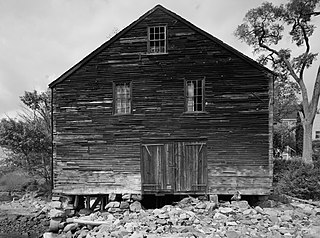
The Gerrish Warehouse was a historic 18th-century warehouse, located on Pepperrell Cove in Kittery Point, Maine. Built c. 1710, it was one element of the Pepperrell family's shipping empire, notably run in the mid-18th century by Sir William Pepperrell. Converted into a ship chandlery in the 19th century, it was sold to the Maine Maritime Museum in 1976, and was added to the National Register of Historic Places in 1977. The museum's plan to move the building by barge to a new location was judged infeasible, and it was subsequently demolished after the museum had recovered its contents. It was removed from the National Register in 2015.

The Abbe Museum is a museum with two locations in Bar Harbor, Maine, on Mount Desert Island. The museum is dedicated to exploring the history and culture of Maine's Native people, the Wabanaki. It has one location at 26 Mount Desert Street in the center of Bar Harbor, and a second location at Sieur de Monts in Acadia National Park. The Sieur de Monts building is an architecturally distinctive structure, listed on the National Register of Historic Places as one of the state's first purpose-built museum buildings, and as a rare example in the state of Mediterranean architecture.

The Granite Store is a historic commercial building in United States Route 1 in Sullivan, Maine. It is an unusual example of Greek Revival architecture, executed in rough-cut granite, probably built between 1835 and 1850. The building was listed on the National Register of Historic Places in 1974. It is now apparently in residential use.

Seawall Campground is a campground in Acadia National Park on Mount Desert Island off the coast of Maine. The campground offers four loops of campsites, including "drive-up" sites suitable for RVs and trailers, as well as walk-in tent-only campsites, and is open from late May into October. Much of the campground was built between 1936 and 1942 by crews of the Civilian Conservation Corps; this section is listed on the National Register of Historic Places. The campground is located in the village of Seawall, in the town of Southwest Harbor on Maine State Route 102A.

The Rankin Block is a historic commercial building at 600-610 Main Street in Rockland, Maine. Built in 1853, it is a fine example of a late Greek Revival commercial block. It was listed on the National Register of Historic Places in 1978. It currently houses a senior living facility.

The Sail Loft is a historic commercial building on Front Street in the Tenants Harbor village of St. George, Maine. Built in 1860, it is one of the only surviving buildings from the village's 19th-century heyday as a shipbuilding center. It was listed on the National Register of Historic Places in 1977.
John Street is a street running north to south through the Financial District of Lower Manhattan in New York City. It is one of the oldest streets in the city. Long associated with maritime activity, the street ran along Burling Slip. The slip was filled in around 1840, and the street widened. Besides a wharf, warehouse, and chandlery, the city's first permanent theatre, and the first Methodist congregation in North America were located on John Street. It was also the site of a well-known pre-Revolutionary clash between the Sons of Liberty and British soldiers, pre-dating the Boston Massacre by six weeks.

The Acadia Ranch, now the Acadia Ranch Museum and home of the Oracle Historical Society, at 825 E. Mt. Lemmon Highway in Oracle in Pinal County, Arizona, is a historic ranch complex built up during 1885 to 1930. A portion of the ranch was listed on the National Register of Historic Places in 1984. The listing included two contributing buildings: the Acadia Ranch House and an outbuilding which includes a smokehouse and a garage. It also included a contributing structure: a water tower.




















